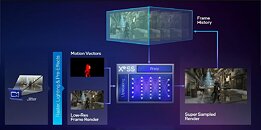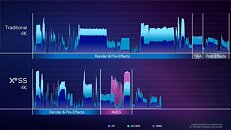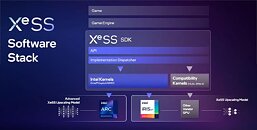- Joined
- Oct 9, 2007
- Messages
- 47,676 (7.43/day)
- Location
- Dublin, Ireland
| System Name | RBMK-1000 |
|---|---|
| Processor | AMD Ryzen 7 5700G |
| Motherboard | Gigabyte B550 AORUS Elite V2 |
| Cooling | DeepCool Gammax L240 V2 |
| Memory | 2x 16GB DDR4-3200 |
| Video Card(s) | Galax RTX 4070 Ti EX |
| Storage | Samsung 990 1TB |
| Display(s) | BenQ 1440p 60 Hz 27-inch |
| Case | Corsair Carbide 100R |
| Audio Device(s) | ASUS SupremeFX S1220A |
| Power Supply | Cooler Master MWE Gold 650W |
| Mouse | ASUS ROG Strix Impact |
| Keyboard | Gamdias Hermes E2 |
| Software | Windows 11 Pro |
Intel Graphics today posted a technological deep-dive video presentation into how XeSS (Xe Super Sampling), the company's rival to NVIDIA DLSS and AMD FSR, works. XeSS is a gaming performance enhancement technology where your game is rendered by the GPU at a lower resolution than what your display is capable of; while a high-quality upscaling algorithm scales it up to your native resolution while minimizing quality losses associated with classical upscaling methods.
The video details mostly what we gathered from our older articles on how XeSS works. A game's raster and lighting is rendered at a lower-resolution, frame-data along with motion vectors are fed to the XeSS upscaling algorithm, and is then passed on to the renderer's post-processing and the native-resolution HUD is applied. The XeSS upscaler takes not just motion vector and the all important frame inputs, but also temporal data from processed (upscaled) frames, so a pre-trained AI could better reconstruct details.




What's new in today's presentation is that a set of performance numbers obtained on the flagship Arc A770 desktop graphics card were posted, showing how XeSS impacts performance across a set of games that include Ghostwire Tokyo, Hitman 3, Arcadegeddon, SoTR, Diofield Chronicle, Super People, Redout 2, and Chivalry 2. They also walked us through the various quality presets of XeSS that include Ultra Quality, Quality, Balanced, and Performance.


Also revealed is that Intel Graphics is working with UL Benchmarks to add a new XeSS Feature Test to 3DMark, much like the DLSS benchmark of the test. Much like AMD FSR, Intel claims the XeSS is easy to implement on a variety of game engines, and while it benefits tremendously from the XMX matrix-math accelerators of Xe-HPG GPUs, it has a DP4a motion-vector fallback that lets its support not just older Intel architectures (such as Xe-LP), but also rival GPU brands.


Intel once again detailed the broad list of games that will support XeSS, and the big AAA name here is the upcoming "Call of Duty: Modern Warfare II," which will get XeSS support at launch (October 28).
The video can be watched here:
View at TechPowerUp Main Site | Source
The video details mostly what we gathered from our older articles on how XeSS works. A game's raster and lighting is rendered at a lower-resolution, frame-data along with motion vectors are fed to the XeSS upscaling algorithm, and is then passed on to the renderer's post-processing and the native-resolution HUD is applied. The XeSS upscaler takes not just motion vector and the all important frame inputs, but also temporal data from processed (upscaled) frames, so a pre-trained AI could better reconstruct details.




What's new in today's presentation is that a set of performance numbers obtained on the flagship Arc A770 desktop graphics card were posted, showing how XeSS impacts performance across a set of games that include Ghostwire Tokyo, Hitman 3, Arcadegeddon, SoTR, Diofield Chronicle, Super People, Redout 2, and Chivalry 2. They also walked us through the various quality presets of XeSS that include Ultra Quality, Quality, Balanced, and Performance.


Also revealed is that Intel Graphics is working with UL Benchmarks to add a new XeSS Feature Test to 3DMark, much like the DLSS benchmark of the test. Much like AMD FSR, Intel claims the XeSS is easy to implement on a variety of game engines, and while it benefits tremendously from the XMX matrix-math accelerators of Xe-HPG GPUs, it has a DP4a motion-vector fallback that lets its support not just older Intel architectures (such as Xe-LP), but also rival GPU brands.


Intel once again detailed the broad list of games that will support XeSS, and the big AAA name here is the upcoming "Call of Duty: Modern Warfare II," which will get XeSS support at launch (October 28).
The video can be watched here:
View at TechPowerUp Main Site | Source







